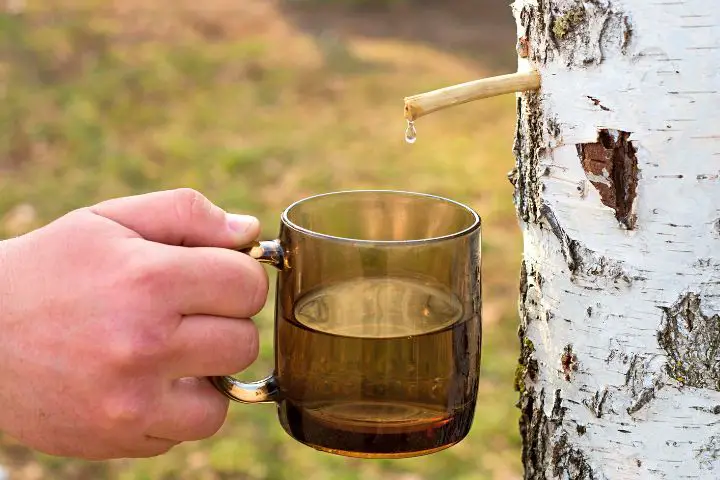Tree Resin vs Tree Sap | Are they the same?… Not quite!
What is Tree Resin?
Tree resin is a naturally occurring substance that is formed by many plants and trees in response to damage. It is a viscous liquid that oozes or flows from wounds or cracks in the bark of a tree. It is a complex mixture of terpenes, hydrocarbons, and other organic compounds like alcohols, esters, and ketones. The chemical composition of resin varies from species to species.
Tree resin is usually yellow, brown, or golden red in color. It can be soft and sticky when freshly poured out from a tree, but it hardens over time and can become brittle.
What is Tree Sap?
Tree sap is a fluid that is produced by most plants and trees as part of their normal metabolic process. It consists mostly of water with various amounts of dissolved minerals, sugars, amino acids, proteins, hormones and other substances.
Tree sap can be clear to opaque in color depending on the species of tree and its maturity level. It is usually thick and sticky when it first comes out of the tree, but it quickly becomes thin and watery after being exposed to air or sunlight for some time.
Is Tree Resin the Same as Tree Sap?
Tree resin is a thick, sticky substance that is produced by trees as a defense mechanism against pests and diseases. It is composed of a mixture of organic compounds, including terpenes and other volatile oils. Resin is typically found in the bark and leaves of trees and is often produced in response to injury or infection.

Tree sap, on the other hand, is a clear, sticky fluid that is produced by trees and is composed of water, sugars, and other organic compounds. It is produced in the tree’s vascular system, which includes the xylem and phloem tissue, and is responsible for transporting water and nutrients throughout the tree. As the sap moves through the tree, it also collects sugars and other nutrients from the tree’s leaves and branches.
Tree resin and tree sap are both naturally occurring substances produced by trees in response to damage or metabolic processes respectively. Each has its own physical characteristics that make them unique from one another. And each offers different benefits to our health and environment when utilized responsibly.
While both tree resin and tree sap are produced by trees as part of their natural processes, resin is produced as a defense mechanism against pests and diseases. Sap is produced to transport water and nutrients throughout the tree.
How Can You Tell the Difference Between Tree Resin and Tree Sap?
- Composition: One way to differentiate between tree resin and tree sap is by examining their composition. Tree resin is composed of a mixture of organic compounds, including terpenes and other volatile oils. Tree sap, on the other hand, is composed of water, sugars, and other organic compounds.
- Appearance: Another way to differentiate between tree resin and tree sap is by their appearance. Tree resin is typically a thicker, more solid substance than tree sap, which is a clear, sticky fluid.
- Location: Tree resin is typically found in the bark and leaves of trees, while tree sap is produced in the tree’s vascular system and can be found throughout the tree.
- Collection methods: Tree resin is typically collected by making incisions in the bark of the tree, while tree sap is collected by tapping the tree.
What Can Tree Sap and Tree Resin Be Used for?
Tree resin has many uses that have been used for centuries. In addition to its medical uses, tree resin is also used as a sealant. It can be used to waterproof objects and protect them from dirt, dust, and moisture. It is also used as an adhesive for crafting and furniture making.
Tree sap has many uses across many industries. It has been used for centuries as a natural sweetener in food products such as candy and syrup. Tree sap can also be used to produce biofuel which can be used to power vehicles or machinery in place of traditional fossil fuels.
It is also an important ingredient in many skincare products thanks to its naturally hydrating properties that can help keep skin soft and supple. In addition, it has been found to have antiseptic properties that can help protect against germs and bacteria which makes it a great natural remedy for treating minor cuts and scrapes.

Health Benefits of Tree Resin
It is mainly used for its antiseptic properties, as it can help protect trees from fungal infections, disease, and decay. Resin has also been used for medical purposes such as treating skin ailments, reducing inflammation, and healing wounds. With antimicrobial properties, resin can help fight off bacteria, fungi, and viruses, making it a great natural remedy for treating skin conditions such as acne, eczema, and psoriasis.
It also contains antioxidant properties which can help reduce inflammation in the body. This can help reduce pain, swelling, and discomfort associated with arthritis and other inflammatory conditions. Finally, tree resin has been found to have anti-carcinogenic properties that may help to reduce the risk of certain cancers.
Environmental Benefits of Tree Resin
Tree resin also offers many environmental benefits as well. It helps protect trees from diseases and decay which can help preserve the life of trees and prevent them from being cut down prematurely.
Tree resin is also biodegradable which means it won’t harm the environment if it is released into the air or water. Finally, it can be used as an excellent natural adhesive which means less plastic needs to be produced for industrial purposes.
Health Benefits of Tree Sap
Tree sap has many health benefits as well. It contains natural sugars that can provide us with energy throughout the day without the crash that comes with refined sugars. It also contains natural antioxidants that may help reduce inflammation in the body which can help reduce pain associated with arthritic conditions or other chronic illnesses.
Finally, tree sap is a rich source of vitamins and minerals such as magnesium and potassium that can help support a healthy immune system and boost overall well-being.

Environmental Benefits of Tree Sap
Tree sap also offers many environmental benefits as well. As a biofuel, it can be used as an alternative to fossil fuels which helps reduce dependence on non-renewable resources while reducing harmful greenhouse gas emissions into our atmosphere.
Tree sap is also biodegradable which means it won’t harm the environment if it is released into the air or water like some other petroleum-based products might do. Finally, using tree sap helps preserve trees since it doesn’t require cutting them down as traditional wood production does.






